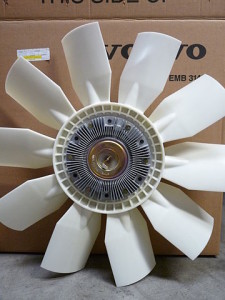What is a Radiator Cooling Fan?
A radiator cooling fan is device that can help regulate engine temperature by pulling air through a radiator. Although a cooling fan can be necessary to prevent an engine from overheating, these fans aren’t responsible for the majority of the cooling performed by radiators. There are also two main types of radiator fans: mechanical and electric. Mechanical radiator cooling fans are belt driven, and electric fans use DC motors that run off the vehicle’s electrical system.
Contents
How Does a Radiator Cooling Fan Work?
Radiator fans work by pulling or pushing air through a radiator. Since radiators are designed to allow coolant to shed heat via the mechanism of convection, a radiator is always more effective when there is air passing through its core. However, cooling fans are not responsible for the majority of airflow through radiators in most applications.
During normal operation, the forward motion of a vehicle forces air into the front grill and through the radiator. This airflow can account for as much as 95 percent of the actual cooling that a radiator performs, and a cooling system that is operating properly typically doesn’t even need a radiator fan when the vehicle is moving.
When a vehicle isn’t moving, and under heavy load stresses, a cooling fan provides the extra airflow that can prevent an engine from overheating. To that end, most cooling fans are designed to only push or pull air when needed. Some older mechanical cooling fans are “always on,” but that creates an unnecessary load on the engine at all times.
Mechanical Radiator Fans
The first radiator fans were mechanical in nature, and fans of this type are still in use today. Mechanical cooling fans are belt driven, which means that they are attached to a pulley that is connected to the crankshaft via a drive belt. When the crank shaft rotates, the fan pulley also rotates, and the fan either pushes or pulls air through the radiator. In many applications, the radiator fan will actually be bolted up to the water pump pulley.
The simplest mechanical radiator fans are “always on,” in that they spin and either push or pull air whenever the engine is running. However, there are a couple different types of fan clutches that can allow a mechanical cooling fan to “switch” off and on according to the temperature of the engine.
The two main types of cooling fan clutches are:
- viscous-drive clutches
- electric fan clutches
Viscous-drive clutches utilize a fluid coupling that allows the fan to engage when a specific engine temperature is achieved. These fan clutches contain bi-metallic sensors that work something like those found in thermostats. When the engine is cold, the clutch is decoupled, and the fan freewheels. Then, when the engine heats up, the bi-metallic sensor causes the viscous coupling to engage, and the fan spins along with the pulley it is attached to.
Electric fan clutches work like viscous clutches, but they can be switched off and on by the engine control unit based on a variety of conditions. This can allow the operation of a mechanical cooling can to be tightly controlled.
Electric Cooling Fans
Rather than being powered directly by the engine, electric cooling fans are powered by the electrical system. These radiator fans use DC motors that can be switched on and off either by the engine control unit or directly by a coolant temperature switch. They also typically bolt directly to either the front or back of a radiator along with an integrated fan shroud.
Radiator Cooling Fan Failure
There are a few different factors that can lead to a radiator cooling fan failure. Mechanical fans that are “always on” don’t fail, per se, but a bad bearing will cause them to spin erratically and potentially damage the fan shroud and other components.
When a mechanical cooling fan has a clutch, that is the most common point of failure. Viscous clutches can lock to the point where they always spin, which may cause an engine to run too cool. They can also fail in a way they won’t engage at all, which can cause overheating when the vehicle is idling. Electric fan clutches can fail in those same ways, but the root cause can be in sensors, wiring, or even the ECU.
Electric cooling fan failure can be due to a failed DC fan motor, but the cooling temperature sensor or switch is also a likely culprit. In either case, it’s a good idea to check the sensors before simply replacing the fan. Although electric cooling fans are often easy to replace, they can be expensive.
Since radiator cooling fans aren’t responsible for the bulk of the cooling performed by radiators, a failed cooling fan doesn’t necessarily mean that the engine will overheat. If the engine starts to overheat at idle, but it doesn’t overheat when the vehicle is moving, then turning on the heat may help. This is due to the fact that the heater core blower motor will help remove heat from the cooling system just like the radiator fan normally would.









